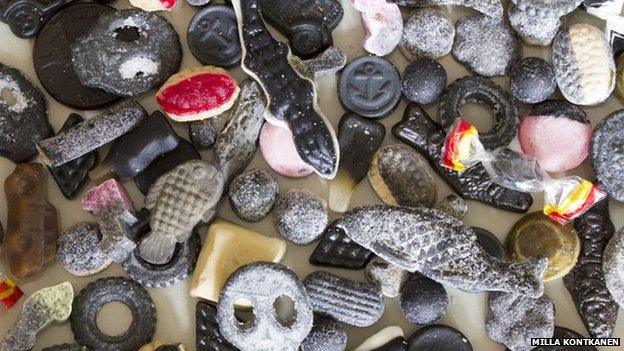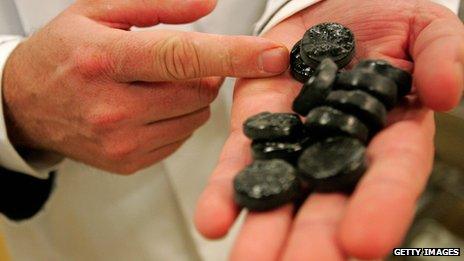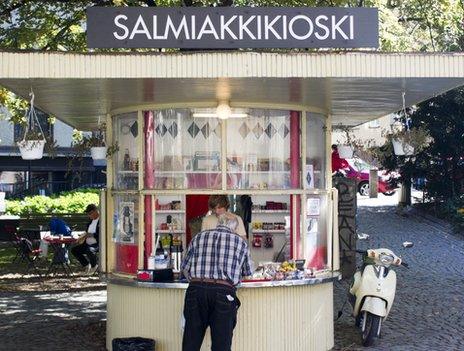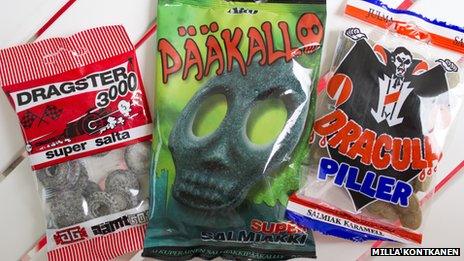Salty liquorice: The not-so-sweet sweet
- Published

Salty liquorice is an acquired taste - and many in Finland, Scandinavia and the Netherlands learn to love its sharp, sour flavours during childhood. But for those who are introduced to it later in life, the black stuff can be hard to stomach.
This was obviously some sort of test.
As I bit into the grey ice cream covered in a thick black coating, an overwhelmingly unpleasant sourness filled my mouth.
I took another bite. Why is there salt in my ice cream? After two bites I had had enough.
It was the summer of 2002 and it was my first encounter with salty liquorice, or Finnish salmiakki.
The Finnish woman who bought it for me laughed. The test had proved that the Finns have their own distinctive - and slightly odd - taste.
I was adamant this would be my only encounter with salmiakki. But little did I know that this was just the beginning.
Salmiakki is a soft liquorice with ammonium chloride added to give it its distinctive saltiness. More ammonium chloride means stronger, saltier and more potent salmiakki.
This confectionery - if such a salty snack could be described as such - was thought to have originated in pharmacies who manufactured their own cough medicine. Ammonium chloride - known for being able to break down mucus - was added to the mixture.
No-one is sure when ammonium chloride and liquorice were first combined, but by the 1930s it was being produced in Finland and a number of other countries as confectionery.
Some eight years after my first taste of salmiakki, I was living in London with Milla, the Finnish woman who gave me my first taste of the delicacy. Some Finnish friends came to visit bringing a type known as "bombs" with them.
Within seconds of putting one in my mouth, an intense, sharp, stinging pain spread across my tongue, as if somebody had sandpapered it and then poured salt on top.
After the pain came the salty sourness and I could not stop salivating. I had to spit it out.
Our friends gave the same satisfied look that Milla previously had. So this is what the Finns do for fun, then.
Over the following years more visitors came, most bearing gifts of salmiakki. There were salmiakki feet, cars and skulls.
Many Finns tell me that the first thing they miss when they are abroad is salmiakki. Those who move away ask their friends and relatives to send it to them.

"I always take an emergency supply of salmiakki with me," says Jukka Annala, the chairman of the Finnish salty liquorice association.
Around his kitchen table - which is covered in empty packets of salmiakki - Jukka recalls going to Russia for a month in the early 1990s.
"My host was amazed when I opened my suitcase. There were not many clothes but it was half-full of salmiakki in order for me to survive in that hostile environment of no salty liquorice."
Since moving to Finland with Milla a year ago, I have slowly been working my way through the myriad different types, determined to find a version that I could tolerate or even enjoy.
I tasted soft salmiakki fudge, chocolate filled with liquid salmiakki and a strong pulverised version of salmiakki which is affectionately known as crazy powder.
On a night out with friends in Helsinki I was given a shot of salmiakki-flavoured vodka.
This tiny glass of black liquid posed two immediate problems: I do not drink vodka and I do not like salmiakki.

When I thought I knew all there was to know about the salty snack, I stumbled upon the Salmiakkikioski in Helsinki.
This old, wooden, roadside kiosk is where the aficionados come - some of them sporting salmiakki tattoos.
A hundred different types of salmiakki are available - from fish and bananas to pipes - a in a dazzling array of brightly coloured packets.
The owner, Pete Neuvonen, says salmiakki is a big part of Finland's cultural heritage. He considers it to be even more important than saunas and Sibelius.
"It is a flavour that you grow up with and there's some comfort in that," he says. "You go back to your childhood.
"It is a strange thing to explain. If you are not a Finn you probably will not get it."

From a shelf Pete grabs a bag of Dracula salmiakki, complete with a picture of the infamous count with blood coming out of his mouth.
Above the image are the words "Julma Salmiakki". That means cruel salmiakki.
Like so many before, this variety stings my tongue and sets my saliva glands alight. But then something happens. The saltiness and sweetness cross each other.
And then a perfect moment when the two sensations are equal, creating a strong but pleasant sensation.
This is why the Finns like it.
Pete watches me in silence and gives me a knowing smile. "It is good to have a new convert," he says.
From Our Own Correspondent, external: Listen online or download the podcast.
BBC Radio 4: Saturdays at 11:30 and some Thursdays at 11:00
BBC World Service: Short editions Monday-Friday - see World Service programme schedule.
You can follow the Magazine on Twitter, external and on Facebook, external